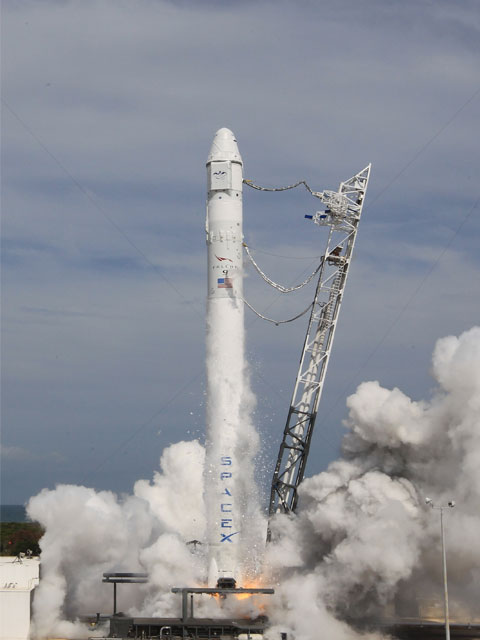First commercial cargo launch to space station imminent

Within a matter of days, or even hours, the commercial space race enters a new realm. The first US commercial space flight to the International Space Station, conducted by Space Exploration Technologies (SpaceX), a private company, is set to launch on Saturday, May 19th, if all goes well.

UPDATE 5-31-2012: The Dragon capsule made a successfully re-entry to earth, splash-landing in the Pacific at at approximately 8:42 AM Pacific/11:42 AM Eastern, SpaceX announced.
UPDATE 5-25-2012: The Dragon space capsule successfully docked with the International Space Station, becoming the first commercial spacecraft to attach there. The capsule is scheduled to return to earth May 31st.
UPDATE 5-22-2012: The spacecraft was successfully launched at 3:44 a.m. Eastern Time, with the Falcon 9 carrying Dragon launched from SpaceX’s launch pad. Now Dragon heads toward the International Space Station.
UPDATE 5-19-2012: The launch was aborted on the first attempt. SpaceX reports "slightly high combustion chamber pressure on engine 5, which prompted the computer to abort the countdown. We are reviewing the data." The next attempt was scheduled for May 22nd.)
SpaceX will launch its Dragon space capsule on top of a Falcon 9 rocket from NASA's Cape Canaveral launch complex.
The SpaceX craft may potentially serve as a cost-effective replacement for the recently retired NASA Space Shuttle. It also opens the door to a new era of private space travel, either flying on their own ventures, or contracted by government agencies such as NASA.
"We've been working very closely with SpaceX, who is the industry partner on this mission," Lori Garver, deputy administrator for NASA, told Federal News Radio. "The company has been reviewing all of the flight-readiness activities that used to be NASA's job."
The SpaceX launch represents the first attempt by a commercial company to send a spacecraft to the space station. SpaceX says this will be a "demonstration mission," intended to provide NASA and SpaceX with valuable insight to ensure successful future missions.
Dragon will deliver food, research materials, and computer supplies to ISS. During the mission, Dragon must perform a series of complex tasks, each presenting significant technical challenges. Dragon will first orbit the Earth for four days while mission controllers test the spacecraft's systems and sensors to determine if the vehicle is ready to berth with the space station. These tests include maneuvers and systems checks that see the vehicle come within 1.5 miles of the station.
Once NASA gives the go-ahead to dock with the station, Dragon will be captured by station’s robotic arm and attached to the station. ISS astronauts will then open Dragon’s hatch, unload supplies and fill Dragon with return cargo. After approximately two weeks, Dragon will detach from the station and returns to Earth, landing in the Pacific, hundreds of miles west of Southern California.
This is SpaceX's second demonstration flight under a 2006 Commercial Orbital Transportation Services (COTS) agreement with NASA to develop the capability to carry cargo to and from the International Space Station. To date, SpaceX has received $381 million for completing 37 out of 40 milestones worth a possible $396 million set in that agreement. Completed milestones include the first test flight in December 2010, during which SpaceX became the first commercial company to send a spacecraft to low-Earth orbit and
recover it successfully.
Once SpaceX has successfully demonstrated Dragon’s ability to berth with the space station, it will begin to fulfill a 2008 contract signed with NASA for a minimum of 12 flights carrying supplies to and from the space station. Without the space shuttle, Dragon is the only spacecraft in the world capable of returning significant cargo from the space station.
Falcon 9 and Dragon were designed to carry astronauts in the future; these cargo missions will yield valuable flight experience toward this goal, SpaceX says. Recently, and Bigelow Aerospace (BA) announced an agreement to conduct a joint marketing effort to offer rides on SpaceX’s Dragon spacecraft, using the Falcon launch vehicle to carry passengers to Bigelow habitats orbiting the earth.
Along with the COTS program, NASA is working with private space companies on a number of levels. Last August, the agency announced it contracted with seven companies to integrate and fly technology payloads on suborbital commercial flights into space. NASA's Flight Opportunities Program enables the agency to draw from a pool of commercial space companies to deliver payload integration and flight services. The flights will carry a variety of payloads to help meet the agency's research and technology needs. Through these indefinite-delivery, indefinite-quantity contracts, NASA intends to provide frequent flight opportunities for payloads on suborbital platforms. The selected companies include Armadillo Aerospace, Near Space Corp., Masten Space Systems, Up Aerospace Inc., Virgin Galactic, Whittinghill Aerospace LLC, and XCOR.
As astrophysicist Neil deGrasse Tyson pointed out, we need to put imagination back into our space efforts. Perhaps the innovation that a private space race can create will revive many dreams.
This post was originally published on Smartplanet.com